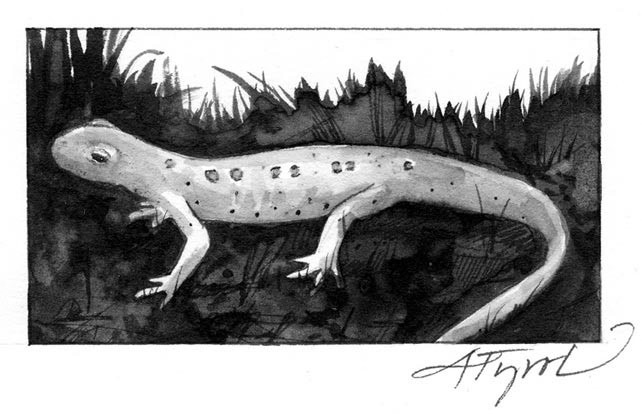
When we bought our old farmhouse 40 years ago, its source of water was a spring that gushed from a hillside. The water seemed clean thanks in part to gravel that had been placed on the muddy bottom and to a loose wooden lid that covered the spring itself. The water was so hard it caked teapots and made it almost impossible to lather in the shower, but it was cold and delicious.
Before my wife and I made the permanent move to the house in St. Johnsbury, Vt., our daughter and her family lived there, while gathering resources to build their own home. The spring seemed to serve them well.
One evening we received a phone call. Our daughter had noticed tiny fleshy hands and feet and other bits of macerated flesh sticking to her shoulders after taking a shower. That she was distressed is to understate the situation. Oral description and my familiarity with fresh-water biology suggested these were parts of newts that had the misfortune of being killed by a jet pump I had installed to increase water velocity. I suggested to my daughter screening and gently removing the aquatic creatures at their source, but she would have none of it. Her husband took several gallons of Clorox to the spring, poured in the bleach, and surely danced gleefully as the little amphibians turned belly-up. The family drank bottled water for months afterward, while parts of newts he hadn’t killed continued pouring from faucets.
When I came north in the summer, I inspected the spring, replaced the wooden cover with a concrete lid and took several other steps to deny creature access. I told my daughter and son-in-law of the improvements, and life in their household returned to normal.
While forced to bar these amphibians from entering our water supply, I had a chance to reflect on them. And I found them most interesting as, apparently, did New Hampshire in 1985, when it named the spotted newt the official state amphibian. (Vermont went with the northern leopard frog.) The newt’s life is intriguing in part because it comes in three stages.
After hatching in water in springtime, the larval forms can be found feeding near the bottom of ponds, or, in our case, a spring. These larvae have feathery gills, either no legs, or very weak ones, and, like fish, extract oxygen from the water. They cannot in this stage survive on land. Later, the larvae metamorphose into what I consider to be one of the prettiest creatures in the Northern Forest: the terrestrial red eft.
The red eft has lungs for breathing and splayed legs sturdy enough to support overland travel. Its warty skin is bright orange or red, with scattered black dots. It is easy to become entranced when you see one crawling across a dirt road or resting on green moss. Children are intrigued by such living treasures and are inclined to bring them home. But they probably shouldn’t, for two reasons: First, amateur efforts to keep them healthy outside of their natural habitat often fail; and second, efts produce toxins in their skin glands that can affect people or pets. One toxin, tetrodotoxin, is the same dangerous poison found in puffer fish. The eft’s orange-red color serves as a warning to predators, so efts often are able stroll in the open undisturbed by birds or other creatures looking for easy meals.
Red efts in turn metamorphose into eastern red-spotted newts, which return to water where their life cycle began. Their color changes to olive-green with scattered red dots; and though they are only about one-tenth as toxic as efts, the red dots still serve as a helpful reminder to would-be predators they are not to be fooled with. They retain the air-breathing lungs of their eft stage, but their tails become flattened to help propel them through water, their legs becoming relaxed and dangling as they go.
A newt’s legs work well when the animal walks along the bottom of pond or spring, or when the male clasps a female in an aquatic mating ritual. But the legs won’t be taking a newt across land — unless the pond is drying up and it needs to find a new place to live.
How dangerous is eft-newt toxin? If consumed, either stage of the amphibian can sicken a person or kill a small animal. If an eft is handled and its skin secretions enter a cut, a serious reaction might occur. Some advice: Pay attention to nature’s most colorful signs, because often they are warnings.
As I told my daughter, who was not especially amused: “No newts can be good newts!”


Discussion *